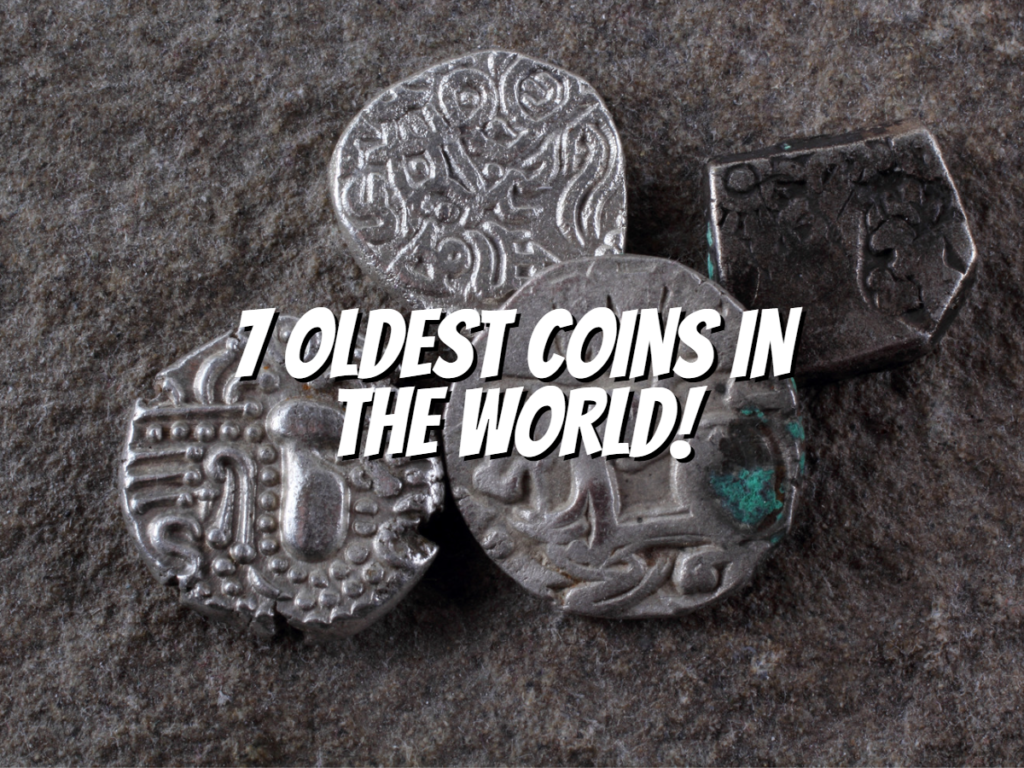The oldest coins in the world have been unearthed from ancient civilizations, and these coins are considered some of the most valuable objects in history thanks to their high purity levels and intricate design.
Although few, these ancient coins have survived centuries of wear and tear by being passed down through generations. Let’s take a look at seven of these rare treasures!
7 Oldest Coins in the World:
1. Hallaton Silver Coin

About 130 silver coins were found by Hallaton Fieldwork Group volunteer Ken Wallace in 2000. Following this finding, a team of local archaeologists dug up the largest hoard of British Iron Age coins ever found, named the Hallaton Treasure.
The team discovered over five thousand silver and gold coins, jewelry, and a silver-gilt Roman parade helmet.
A silver Roman coin from around 211 BCE was discovered in the hoard, making it the oldest Roman coin ever discovered in Britain.
The Roman goddess Roma appears on one side of the coin, and the legendary twins Castor and Pollux ride a horse on the other. S
ome archaeologists have interpreted the coin as proof of trade between Britain and Rome before the Roman invasion of 43 CE.
2. Persian Daric

After 546 BCE, Cyrus the Great, the first Persian Emperor, introduced coins to his empire.
Third Persian Emperor Darius I instituted a new monetary system between 520 and 480 BCE.
He also standardized the gold coin‘s thickness at a weight of 8.4 grams.
Daric was the name given to the coins that came to serve as the Achaemenid Persian Empire’s standard currency.
Daric was of the highest quality and about 95.83% pure gold. They were melted down and remade into coins of Alexander the Great after his invasion of Persia was a success in 330 BCE.
This is probably why daric is so uncommon despite its widespread application.
3. Aegina Sea Turtle

Ancient Aegina was an important trading post for people from Ionia and Lydia.
They witnessed the creation of the first coins and understood their potential as a medium of exchange and a store of value on a global scale.
Coinage was first introduced to Greece by the city-state of Aegina around the middle of the sixth century BCE.
With their uniform appearance, the Aegina coins were the first to be used as currency in international trade. The sea turtle was often engraved in high relief on one side of their coins, while the other featured a punched square pattern.
Aegina coins eventually became accepted throughout what was then the known world.
4. Karshapana

Historians may not agree on when the first Indian coins were produced, but most agree that they were introduced sometime in the sixth century BCE. The Mahajanapadas of the Indo-Gangetic Plain produced these early coins after importing the technique from West Asia. Karshpanas, Puranas, and Panas were the names given to these punched coins.
Coins in ancient India were not circular like those in West Asia. They were decorative metal bars with a variety of stampings. Some coins had a single design, while others had multiple designs punched into them (typically five). The coins were made by slicing silver plates to size, with at least one corner removed.
5. Ying Yuan

The first Western coins appeared when the first Chinese coins were made. The Western model of coinage, which influenced early coins around the world, is not thought to have had any significant impact on the development of Chinese currency.
Possibly as early as 700 BCE, when cowrie shells were used as currency, the Chinese began minting their coins.
The State of Chu issued the era’s first gold coins sometime during the Warring States era. The earliest examples of these coins, Ying Yuan, date back to around 500 or 600 BCE.
They were crude gold squares with yuan characters stamped on them, denoting their weight in monetary terms.
6. Ionian Hemiobols

The ancient city of Cyme, located in the region of Ionia (the modern-day central coast of Turkey), was not far from Lydia (the cradle of coinage).
Political ties linked the two cities, and the “nobleman’s tax tokens” of Lydia inspired Cyme to create its coinage for its citizens.
Cyme’s earliest coins, Hemiobols, were made of a small fraction of silver and featured a horse’s head design.
It is estimated that these coins entered circulation between 600 and 500 BCE, making them the second-oldest in the world.
The Ionian Greeks were the pioneers of using coins (the Hemiobols) for widespread commerce, which contributed to the eventual globalization of the concept of Market Economics.
7. Lydian Lion

The Lydian Lion is generally accepted as the world’s oldest minted coin. These coins were struck in the ancient Kingdom of Lydia, now western Turkey, and thus predate the coinage of ancient Greece.
It is generally agreed that these coins first appeared during the reign of King Alyattes, who ruled Lydia from about 610 to 550 BCE, though some scholars argue that they date back to as early as 700 BCE.
People frequently cite Greek historian Herodotus to support the argument that the Lydians first introduced coinage. He claimed the Lydians pioneered silver and gold currency and brick-and-mortar commerce.
Before you go…
So there you have it! Hope you enjoyed this list of the 7 oldest coins in the world! If you have any questions or suggestions, please leave them in the comment section! Happy Collecting!
Check out my next article: “What is the Rarest Ancient Coin?“
Related Articles:

